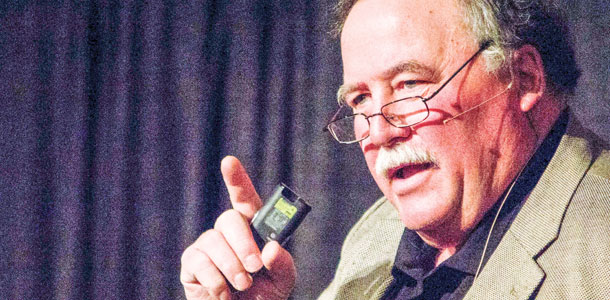Calling ethanol production a “mature industry” that’s not ramping up production, Robb said the volatility of commodities will decrease as the government mandate declines for feedstuffs into fuel. But ranchers shouldn’t expect a drastic drop in the price.
“Corn prices are down; you all know that,” Robb said. “But we’re not going back to $2 a bushel.”
Robb said consumer demand for beef products is surprisingly good due to the quality associated with them. Each segment in the industry will need to observe other segments’ practices and see the economics driving profitability.
“Windows of opportunity don’t come very often in this industry, and you need to understand the scale and magnitude of potential returns.”
Asia a key to trade expansion

Gregg Doud of the Commodity Markets Council said foreign markets are attracting new money into the beef market. Today’s industry routinely sees 17 percent of the money paying for cattle coming from foreign currency.
“Our customers are global, and we have to begin to think in terms that our product is going to 70 or 80 countries around the world,” Doud said.
Markets in Asia are especially fruitful at this point, Doud said, citing Trans Pacific Partnership efforts to move toward lower tariffs in Japan and South Korea.
Japan’s purchases of U.S. beef are linked with the trade restrictions lifted last year and could be increased if domestic ag subsidies are reduced in that country.
Japan is also trying to buy more U.S. natural gas after its nuclear troubles. Doud said the goal is to include conditions that Japan free up more beef trade routes as the U.S. sells more natural gas.
China is also moving heavily toward U.S. beef import growth through the neighboring destinations of Vietnam and Hong Kong. The Chinese market now pays more on beef cuts than ever before.
Doud warned that political parties in Washington – on the left and the right – are voicing more criticism of trade agreements.
“For agricultural folks, that’s a death sentence if we can’t continue to open markets. We can’t afford to have that kind of mindset in Washington. It’s just dangerous.”
Profits and excess capacity

Tom Brink, formerly of JBS Five Rivers feedlot and now an independent buyer, said today’s feeders continue to seek healthy calves, short yearlings and yearling cattle that grow and grade.
But the challenge remains, “there are still way too many average cattle out there. Maybe they’re not the worst cattle, but how much value are they creating?” he said.
Today’s cow-calf producers must focus on the grow-grade balance with an eye toward the other segments.
“Even better would be way-above-average growth and carcass value potential,” he said. “If we lean too far one way or the other way, we’re going to be less profitable.”
Brink cited four game-changing dynamics for beef producers in the coming year: higher cow-calf profits, excess feeding capacity, success with timed-A.I. programs and stronger genetics boosting industry output.
“I believe we’re going to see profitability at cow-calf levels that may be as much as $250 to $500 per head over cash costs.”
Brink said most assessments have U.S. feeders facing excess capacity between 20 to 25 percent (22 percent excess capacity would be a shortage of close to 6.2 million head of cattle).
Beef demand at home

Drought, feed prices and management issues led to a heavy cull pattern the past several years, said CattleFax analyst Chad Spearman. That should begin to taper off in the coming year.
While predicting a national beef cow decline of around 300,000 head on Jan. 1, 2014, the trend should reverse.
“The opportunity is here that we may finally see inventory stabilize and actually see an increase on Jan. 1, 2015,” Spearman said.
While the lower herd size and high slaughter trends have created higher calf and beef prices over the past four years, Spearman offered caution as they related to beef demand.
The per-capita U.S. net beef supply is currently at 56.2 pounds per capita and will keep dropping over the next two years to 51.7 pounds, Spearman said, thanks in large part to more exports of U.S. beef.
The trade boom will only push beef prices up higher at home. Meanwhile, affordable corn will help pork and poultry ramp up production – something the beef industry hasn’t done yet.
This leads to more price issues at the meat case for the American buyer.
“What is the most competitive protein?” Spearman asked. “When a shopper goes to a grocery store looking to spend $7, how are they going to spend that? By buying one steak or 30 drumsticks?” ![]()

On economically relevant traits: “In all cases, there’s more than one trait that determines how much money we make in the business.
With that perspective, when we go to make a bull purchase decision or choose our replacements, we really want to improve multiple traits at a time.”
Mark Enns, beef geneticist
Colorado State University

On managing annual cow costs: “A lot of times when I do spot analysis with producers to analyze their production and financial costs, we’ll say the same thing: Figure out how you don’t need it. Depreciation can be extremely expensive.”
Julie Walker, beef specialist
South Dakota State University

We can create more value with our same resources, by tracing these cattle, using high-quality genetics, and putting them through the feedyard and using the tech we have today, and not spend a dime more doing it.”
Mike Kasten, program director
Missouri Quality Beef
-From David Cooper news release











